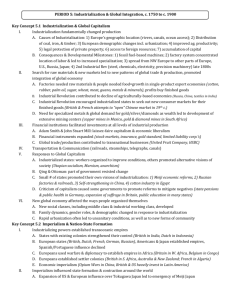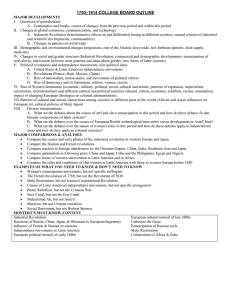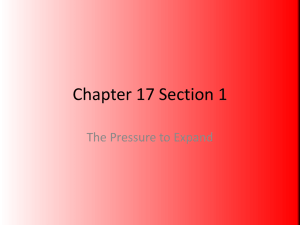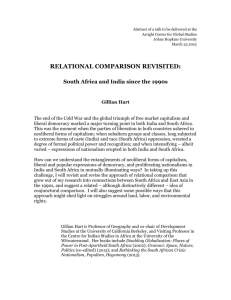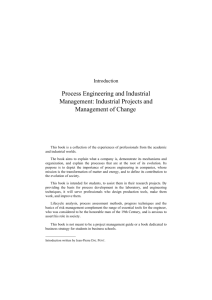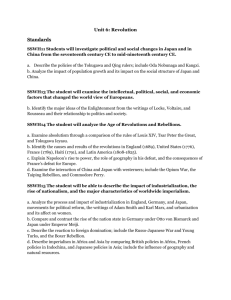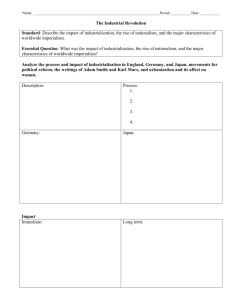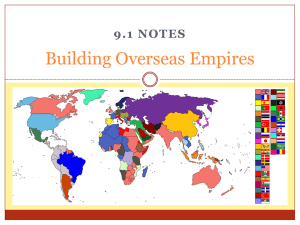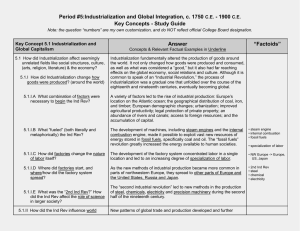PERIOD 5: Industrialization and Global Integration, c. 1750 to c
advertisement
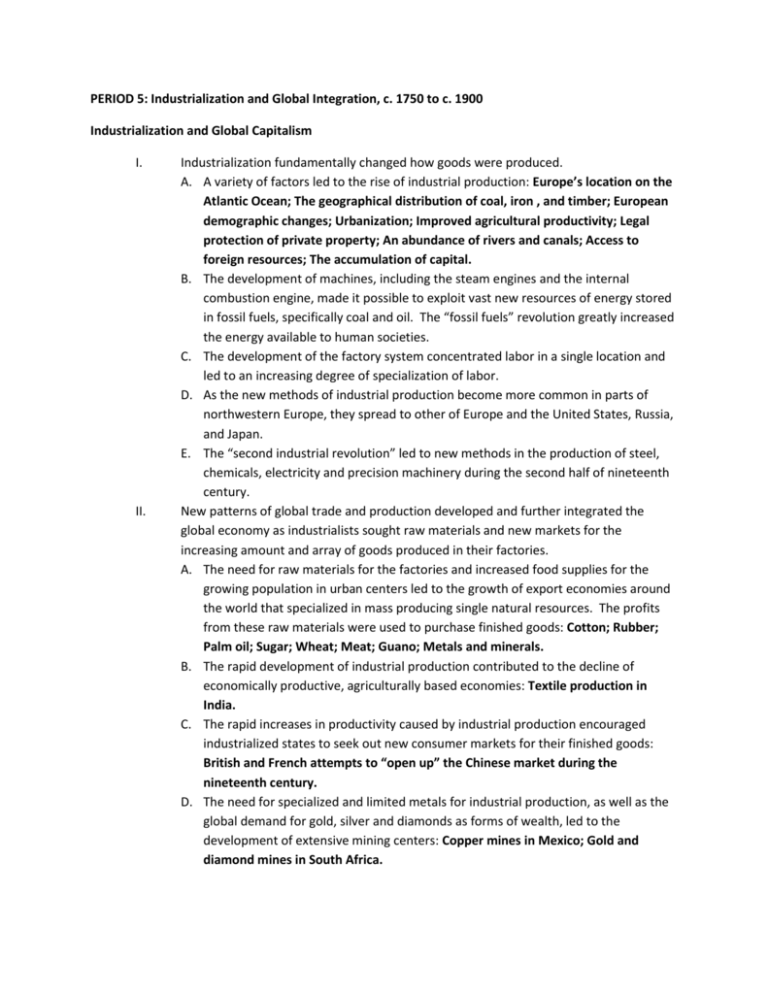
PERIOD 5: Industrialization and Global Integration, c. 1750 to c. 1900 Industrialization and Global Capitalism I. II. Industrialization fundamentally changed how goods were produced. A. A variety of factors led to the rise of industrial production: Europe’s location on the Atlantic Ocean; The geographical distribution of coal, iron , and timber; European demographic changes; Urbanization; Improved agricultural productivity; Legal protection of private property; An abundance of rivers and canals; Access to foreign resources; The accumulation of capital. B. The development of machines, including the steam engines and the internal combustion engine, made it possible to exploit vast new resources of energy stored in fossil fuels, specifically coal and oil. The “fossil fuels” revolution greatly increased the energy available to human societies. C. The development of the factory system concentrated labor in a single location and led to an increasing degree of specialization of labor. D. As the new methods of industrial production become more common in parts of northwestern Europe, they spread to other of Europe and the United States, Russia, and Japan. E. The “second industrial revolution” led to new methods in the production of steel, chemicals, electricity and precision machinery during the second half of nineteenth century. New patterns of global trade and production developed and further integrated the global economy as industrialists sought raw materials and new markets for the increasing amount and array of goods produced in their factories. A. The need for raw materials for the factories and increased food supplies for the growing population in urban centers led to the growth of export economies around the world that specialized in mass producing single natural resources. The profits from these raw materials were used to purchase finished goods: Cotton; Rubber; Palm oil; Sugar; Wheat; Meat; Guano; Metals and minerals. B. The rapid development of industrial production contributed to the decline of economically productive, agriculturally based economies: Textile production in India. C. The rapid increases in productivity caused by industrial production encouraged industrialized states to seek out new consumer markets for their finished goods: British and French attempts to “open up” the Chinese market during the nineteenth century. D. The need for specialized and limited metals for industrial production, as well as the global demand for gold, silver and diamonds as forms of wealth, led to the development of extensive mining centers: Copper mines in Mexico; Gold and diamond mines in South Africa. III. IV. V. VI. To facilitate investments at all levels of industrial production, financiers developed and expanded various institutions. A. The ideological inspiration for economic changes lies in the development of capitalism and classical liberalism associated with Adam Smith and John Stuart Mill. B. Financial instruments expanded: Stock markets; Insurance; Gold Standard; Limited liability corporations. C. The global nature of trade and production contributed to the proliferation of largescale transnational businesses: The United Fruit Company; The HSBC – Hong Kong and Shanghai Banking Corporation. There were major developments in transportation and communication: Railroads; Steamships; Telegraphs; Canals. The development and spread of global capitalism led to a variety of responses. A. In industrialized states, many workers organized themselves to improve working conditions, limit hours, and gain higher wages, whole others opposed capitalist exploitation of workers by promoting alternative visions of society: Utopian socialism; Marxism; Anarchism. B. In Qing China and the Ottoman Empire, some members of the government resisted economic change and attempted to maintain preindustrial forms of economic production. C. In a small number of states, governments promoted their own state-sponsored visions of industrialization: The economic reforms of Meiji Japan; The development of factories and railroads in Tsarist Russia; China’s Self-Strengthening Movement; Muhammad Ali’s development of a cotton textile industry in Egypt. D. In response to criticisms of industrial global capitalism, some governments mitigated the negative effects of industrial capitalism by promoting various types of reforms: State pensions and public health in Germany; Expansion of suffrage in Britain; Public education in many states. The way people organized themselves into societies also underwent significant transformations in industrialized states due to the fundamental restructuring of the global economy. A. New social classes, including the middle class and the industrial working class, developed. B. Family dynamics, gender roles, and demographics changed in response o industrialization. C. Rapid urbanization that accompanied global capitalism often led to unsanitary conditions, as well as to new forms of community. Imperialism and Nation-State Formation I. Industrializing powers established transoceanic empires. A. States with existing colonies strengthened their control over those colonies: British in India; Dutch in Indonesia. II. III. B. European states, as well as the Americans and the Japanese, established empires throughout Asia and the Pacific, while Spanish and Portuguese influence declined: British; Dutch; French; German; Russian. C. Many European states used both warfare and diplomacy to establish empires in Africa: Britain in West Africa; Belgium in the Congo. D. In some parts of their empires, Europeans established settler colonies: The British in southern Africa, Australia, and New Zealand; The French in Algeria. E. In other parts of the world, industrialized states practiced economic imperialism: The British and French expanding their influence in China through the Opium Wars; The British and the United States investing heavily in Latin America. Imperialism influenced state formation and contraction around the world. A. The expansion of US and European influence over Tokugawa Japan led to the emergence of Meiji Japan. B. The United States and Russia emulated European transoceanic imperialism by expanding their land borders and conquering neighboring territories. C. Anti-imperialism resistance led to the contraction of the Ottoman Empire: The establishment of independent states in the Balkans; Semi-independence in Egypt; French and Italian colonies in North Africa; Later British influence in Egypt. D. New states developed on the edges of existing empires: The Cherokee Nation; Siam; Hawaii; The Zulu Nation. E. The development and spread of nationalism as an ideology fostered new communal identities: The German nation; Filipino nationalism; Liberian nationalism. New radical ideologies, especially Social Darwinism, facilitated and justified imperialism. Nationalism, Revolution, and Reform I. The rise and diffusion of Enlightenment thought that questioned established traditions in all areas of life often preceded the revolutions and rebellions against existing governments. A. Thinkers applied new ways of understanding the natural world to human relationships, encouraging observation and inference in all spheres of life: Voltaire; Rousseau. B. Intellectuals critiqued the role that religion played in public life, insisting on the importance of reason as opposed to revelation. C. Enlightenment thinkers developed new political ideas about the individual, natural rights, and the social contract: Locke; Montesquieu. D. The ideas of Enlightenment thinkers influenced resistance to existing political authority, as reflected in revolutionary documents: The American Declaration of Independence; The French Declaration of the Rights of Man and Citizen; Bolivar’s Jamaica Letter. E. II. III. IV. These ideas influenced many people to challenge existing notions of social relations, which led to the expansion of rights as seen in expanded suffrage, the abolition of slavery and the end of serfdom, as their ideas were implemented. Beginning in the eighteenth century, peoples around the world developed a new sense of commonality based on language, religion, social customs and territory. These newly imagined national communities linked this identity with the borders of the state, while governments used this idea to unite diverse populations. Increasing discontent with imperial rule propelled reformist and revolutionary movements. A. Subjects challenged the centralized imperial governments: The challenge of the Marathas to the Mughal Sultans. B. American colonial subjects led to a series of rebellions, which facilitated the emergence of independent states in the United States, Haiti, and mainland Latin America. French subjects rebelled against their monarchy: American Revolution; French Revolution; Haitian Revolution; Latin American independence movements. C. Slave resistance challenged existing authorities in the Americas: The establishment of Maroon societies. D. Increasing questions about political authority and growing nationalism contributed to anticolonial movements: The Indian Revolt of 1857; The Boxer Rebellion. E. Some of the rebellions were influenced by religious ideas and millenarianism: The Taiping Rebellion; The Ghost Dance; The Xhosa Cattle-Killing Movement. F. Responses to increasingly frequent rebellions led to reforms in imperial policies: The Tanzimat movement; The Self-Strengthening Movement. The global spread of European political and social thought and the increasing number of rebellions stimulated new transnational ideologies and solidarities. A. Discontent with monarchist and imperial rule encouraged the development of political ideologies, including liberalism, socialism, and communism. B. Demands for women’s suffrage and an emergent feminism challenged political and gender hierarchies: Mary Wollstonecraft’s A vindication of the Rights of Woman; Olympe de Gouges’s “Declaration of the Rights of Women and the Female Citizen; The resolutions passed at Seneca Falls. Global Migration I. Migration in many cases was influenced by changes in demography in both industrialized and unindustrialized societies that presented challenges to existing patterns of living. A. Changes in food production and improved medical conditions contributed to a significant global rise in population. B. Because of the nature of the new modes of transportation, both internal and external migrants increasingly relocated to cities. This pattern contributed to the significant global urbanization of the nineteenth century. II. III. Migrants relocated for a variety of reasons. A. Many individuals chose freely to relocate, often in search of work: Manual laborers; Specialized professionals. B. The new global capitalist economy continued to rely on coerced and semicoerced labor migrations: Slavery; Chinese and Indian indentured Servitude; Convict Labor. C. While many migrants permanently relocated, a significant number of temporary and seasonal migrants returned to their home societies: Japanese agricultural workers in the Pacific; Lebanese merchants in the Americas; Italians in Argentina. The large-scale nature of migration, especially in the nineteenth century, produced a variety of consequences and reactions to the increasingly diverse societies on the part of the migrants and the existing populations. A. Due to the physical nature of the labor in demand, migrants tended to be male, leaving women to take on new roles in the home society that had been formerly occupied by men. B. Migrants often created ethnic enclaves in different parts of the world which helped transplant their culture into new environments and facilitated the development of migrant support networks: Chinese in Southeast Asia, the Caribbean, South America, and North America; Indians in East and southern Africa, the Caribbean, and Southeast Asia. C. Receiving societies did not always embrace immigrants, as seen in the various degrees of ethnic and racial prejudice and the ways states attempted to regulate the increased flow of people across their borders: The Chinese Exclusion Act; The White Australia Policy.
